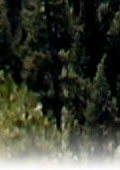Creating
an Effective Defensible Space, Continued
Step
Two: IS
THERE ANY DEAD VEGETATION WITHIN THE RECOMMENDED DEFENSIBLE SPACE AREA?
Dead vegetation includes dead trees and shrubs, dead branches lying on
the ground or still attached to living plants, dried grass, flowers and
weeds, dropped leaves and needles, and firewood stacks. In most instances,
dead vegetation should be removed from the recommended defensible space
area. A description of the types of dead vegetation you're likely to encounter
and the recommended actions are presented below.
|
TYPES
OF DEAD VEGETETION & RECOMMENDED PRACTICE |
|
DEAD FUEL TYPE |
RECOMMENDED PRACTICE |
|
STANDING DEAD TREE |
Remove all standing dead trees from within the defensible space area |
|
DOWN DEAD TREE |
Remove all down dead trees within the defensible space area if they have recently fallen and are not yet embedded into the ground.
Downed trees that are embedded into soil and which cannot be removed without soil disturbance should be left in place.
Remove all exposed branches from an embedded downed dead tree. |
|
DEAD SHRUBS |
Remove all dead shrubs from within the defensible space area. |
|
DRIED GRASSES AND WILDFLOWERS |
Once grasses and wildflowers have dried out or "cured," cut down and remove from the defensible space area. |
|
DEAD NEEDLES, LEAVES, BRANCHES, CONES (ON THE GROUND) |
Reduce thick layers of pine needles to a depth of two inches. Do not remove all needles. Take care not to disturb the "duff" layer
(dark area at the ground surface where needles are decomposing) if present. Remove dead leaves, twigs, cones, and branches. |
|
DEAD NEEDLES, LEAVES, BRANCHES, AND TWIGS (OTHER THAN ON THE GROUND) |
Remove all dead leaves, branches, twigs, and needles still attached to living trees and shrubs to height of 15 feet above ground.
Remove all debris which accumulates on the roof and in rain gutters on a routine basis (at least once annually). |
|
FIREWOOD AND OTHER COMBUSTIBLE DEBRIS |
Locate firewood and other combustible debris (wood scraps, grass clippings, leaf piles, etc.)
at least 30 feet uphill from the house. |
Step
Three:
IS A CONTINUOUS DENSE COVER OF SHRUBS OR TREES PRESENT IN THE RECOMMENDED
DEFENSIBLE SPACE AREA?
Sometimes wildland plants can occur as an uninterrupted layer of vegetation
as opposed to being patchy or widely spaced individual plants. The more
continuous and dense the vegetation, the greater the wildfire threat.
If this situation is present within your recommended defensible space
area, you should "break-it-up" by providing for a separation between plants
or small groups of plants. Also note that areas with steep slopes are often considered high wildfire areas, and may be highly erodable.
When removing shrubs and trees from steep slopes, keep soil disturbance to a minimum.
It may also be necessary to replace flammable vegetation with other plant materials to prevent excessive soil erosion.
RECOMMENDED SEPARATION DISTANCES FOR SHRUBS
& LIVE OAK
For areas with dense brush or thick live oak trees, the recommended separation distance is dependant upon shrub height and steepness of slope.
Specific recommendations are presented below. For example, if your home is located on a 10% slope and the brush is four feet tall,
the separation distance would be two times the shrub height or eight feet. The recommended separation distance can be accomplished by removing plants or through pruning that reduces the diameter or height of shrubs
(shorter height means less separation is needed). Removal works best for buckbrush. For shrubs which readily resprout, such as greenleaf manzanita and deerbrush, pruning to reduce height may be the best approach.
Click
to Open a New Window Showing Illustrations of the Steps to Creating Defensible
Space
|
|
|
|
|
|
|
Note: Separation distances are measured between canopies
(outermost branches) and not between trunks.
|
|
|


